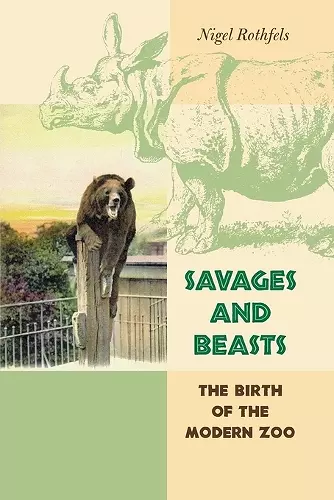Savages and Beasts
The Birth of the Modern Zoo
Format:Paperback
Publisher:Johns Hopkins University Press
Published:29th Jul '08
Currently unavailable, and unfortunately no date known when it will be back

A lucid, sophisticated, and nuanced account of the role that Carl Hagenbeck played in the history of the public exhibition of animals and people. Nigel Rothfels offers a complex but accessible account of the zoo as a cultural institution that has shaped our ideas about animals. The choice of illustrations is excellent and it should find a wide audience among historians, anthropologists, and general readers interested in the relationship between humans and animals. -- Garry Marvin, University of Surrey Roehampton, author of Zoo Culture
Rothfels provides both fascinating reading and much-needed historical perspective on the nature of our relationship with the animal kingdom.To modern sensibilities, nineteenth-century zoos often seem to be unnatural places where animals led miserable lives in cramped, wrought-iron cages. Today zoo animals, in at least the better zoos, wander in open spaces that resemble natural habitats and are enclosed, not by bars, but by moats, cliffs, and other landscape features. In Savages and Beasts, Nigel Rothfels traces the origins of the modern zoo to the efforts of the German animal entrepreneur Carl Hagenbeck. By the late nineteenth century, Hagenbeck had emerged as the world's undisputed leader in the capture and transport of exotic animals. His business included procuring and exhibiting indigenous peoples in highly profitable spectacles throughout Europe and training exotic animals-humanely, Hagenbeck advertised-for circuses around the world. When in 1907 the Hagenbeck Animal Park opened in a village near Hamburg, Germany, Hagenbeck brought together all his business interests in a revolutionary zoological park. He moved wild animals out of their cages and into "natural landscapes" alongside "primitive" peoples from Africa, Asia, the Americas, and the islands of the Pacific. Hagenbeck had invented a new way of imagining captivity: the animals and people on exhibit appeared to be living in the wilds of their native lands. By looking at Hagenbeck's multiple enterprises, Savages and Beasts demonstrates how seemingly enlightened ideas about the role of zoos and the nature of animal captivity developed within the essentially tawdry business of placing exotic creatures on public display. Rothfels provides both fascinating reading and much-needed historical perspective on the nature of our relationship with the animal kingdom.
Rothfels is attuned to the ironies pervading zoos' mediation of people and animals and understands that zoos operate according to entrepreneurial rather than environmental principles... The history of human displays conducted under the guise of anthropology and ethnography has been documented before, but never with such a keen sense of connection between these and zoo operations. Rothfels uses the experience of Carl Hagenbeck, a 19th-century animal dealer and a prominent force behind both zoos and human displays, to document the insidious links between the two enterprises: part of the sordid historical legacy that zoos have never confronted, much less expunged. Chronicle of Higher Education Rothfels... focuses on the 19th-century origins of modern zoos and the man who made it all happen. Carl Hagenbeck, a German animal dealer and zoo visionary, was the owner of the first zoo without bars, and he invented the use of a moated display and many other now-standard techniques. Savages and Beasts is a fine read, in which good use of picture archives has complemented the writer's extensive documentary research. New Scientist It is Nigel Rothfels' great service to show how Carl Hagenbeck's growing experience in mounting his ethnographic spectacles, and his observation of the public's reception of them, led to ideas culminating in a new kind of zoological park... Rothfels has written a genuinely important book for anyone interested in zoos, his perspective is new and convincing. International Zoo News Convincingly argues that the image of Hagenbeck as a modern-day Noah, a great animal lover trying to educate the public about the wonders of nature, belies the basic nature of Hagenbeck's enterprise. That enterprise had very little to do with love for animals, and everything to do with making money. More generally, Rothfels raises questions about past practices of exhibiting animals (and people) and about what zoos of the present are all about. Journal of the History of Biology Important, timely, and stimulating... A rich source on so much; Rothfel's account of Hagenbeck's consolidation of the animal trade, for instance, is exemplary, the mobilization of much research into a lucid exposition of overarching trends. Anthrozoos This is much more than a history of Hagenbeck's many successes. It is an historical explanation for why the environments of zoos today are meant to mask the human character of the places in which animals are forced to live their unnatural lives. American Historical Review 2003 The book is a good read and provides an interesting historical perspective... In short, this is an interesting book; it tells the story of [Carl] Hagenbeck, his peoples and animals from a slightly different perspective. Animal Welfare 2003 Rothfels's work elucidates how zoos offer a carefully scripted version of how human beings should understand animals. Commonweal 2004 A fascinating if disturbing tale of animal and human display. German Studies Review 2005 Savages and Beasts is an excellent book: Rothfels' arguments are subtle and well documented, and complemented by an excellent selection of photographs and illustrations. Limina 2005
ISBN: 9780801889752
Dimensions: 235mm x 156mm x 19mm
Weight: 454g
288 pages